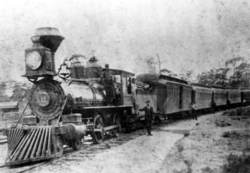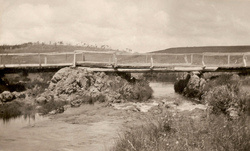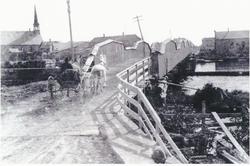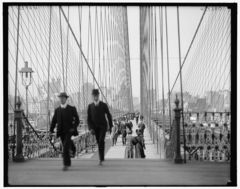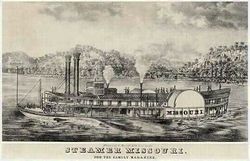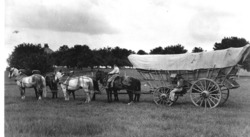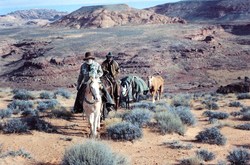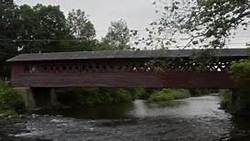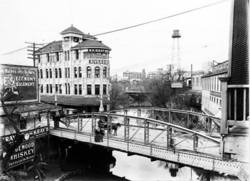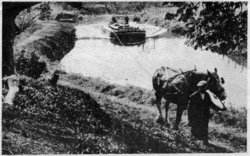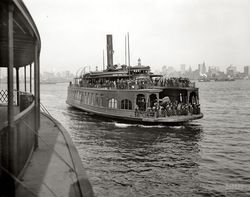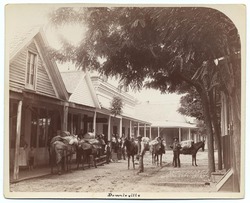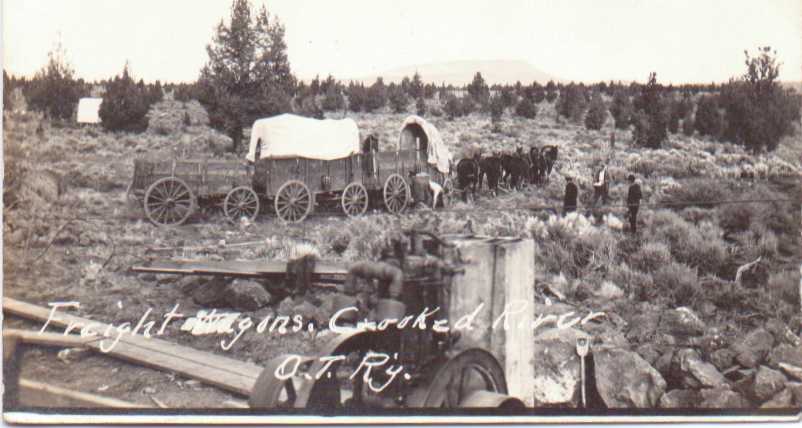Transportation Systems:
Other Types Of Transportation helps Westward Growth:
The increase in roads allowed more people to travel more easily. As people traveled, many stopped to establish a home front in areas which had what was needed to survive. As people grouped in localities, towns emerged along with the improvements needed to serve those people. As towns grew in size, roads were widened and improved in some manner. This is a simple outline showing how generally uninhabited areas became inhabited and then why those areas grew!
The development of the Train, the building of bridges, freight by Conestoga wagons, river travel, and the emergence of mail delivery to the west helped the westward movement of people and the establishment of towns.
Train from the 1850's:
Trains first emerged in the US after the 1830's and by the 1950's were one of the countries largest businesses. After the transcontinental route opened in 1869, thousands traveled cross country yearly. The trains grew from a few routes to what looked like a spiderweb. After the early 1900's, development stopped.
First Crude Log Type Bridges:
Bridge construction begins by the late 1700's but the era of large, long bridges really begins after the 1850's. Because bridges were costly, required extensive labor, and were dependent on larger populations, few were made except in regional settings. Stone bridges date well before America developed (3000 BC) and steel bridges date just before 1800. Wood bridges were more common in the Midwest because trees (wood) was easily accessible, cheap, and there were many who knew how to fabricate with lumber. Long before bridges were common, barges were used to cross waterways. A picture of an early steel suspension bridge as well as a diagram of basic bridge types is located on "Maps II."
Stone & Mortor came by the 1870's:
Steel Bridges Got Longer & Stronger:
As steel get stronger, distances and width's grew. After the early 1900's along with the growth of the automobike, bridge construction really took off.
Steam River Boat from the Post 1845's era:
Steam revolutionized river boating. Boilers often blew up causing much death and destruction. The boats were very popular and grew in numbers till large rivers had bumper to bumper boats around larger cities. Logs in the rivers were a problem as were sandbars. Most boats didn't last long and required a great deal of repair work. There were areas where pirots were a problem.
Early Conestoga Wagon Freighter:
Early freight transport developed slowly and was not consistent except between a few major locations. The problem was developing a system of payment in that the barter system was the primary source of payment. It was often not profitable to carry freight across the great midwest. Travel inland from train depots was the primary source of work and often done by the individual buying the commodity. After the 1880's regular routes developed and carriers might advertise something like 24 days between two specific cities!
The horse was im[prtant to travel in the grest west:
By the early 1800's the horse was a valuable asset. Most couldn't afford one unless it was used as a source of income. To own a horse you had to be able to care for it. A horse was like an automobile today!
Covered Bridge from after 1860's:
Steel Bridges allowed for longer distances and could support more weight:
Horse Drawn Canal Boat:
Canal boats were found all over the east coast. There were sanal boats in other areas but were few in number. These boats were often unprofitable because of the often changing freight needs. Larger rivers between larger cities did much better.
After the 1860's Boat Construction Grew to be Much Better:
As boat construction advanced, especially boiler engineering, boats became much more reliable. Boat travel became not only popular but essential to the growth of the territories served by them. Boats meved more people than freight, however, freight was a major part of the river boat business.
Early Mail Delivery:
Mail delivery began on the east coast but slowly moved westward. First by the Pony Express then as mail increased, additional horses were added. Even after the early 1900's, the horse delivered more mail than petrolium powered vehicles. Even into the 1920's the horse was a necessary for mail delivery. Actually, horses were a necessity because of the really bad roads and the unreliability of the early trucks or automibiles.
Wagon Freightor from the End of the 1800's:
Its hard to imagine today, but in 1900 much "non train" freight was still carried by horse and wagon. Most roads were still bad and heavy wagons dug deep ruts. Inland (non city) Truck freight really didn't grow significantly till after 1910. These wagons were pulled by a whole string of horses because of the bad raods and distances (horses got tired).
Go to "Maps II" for a picture of an early freight truck.
_500x244.jpg)
